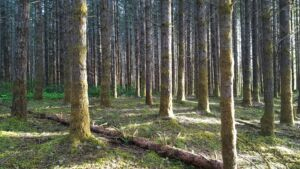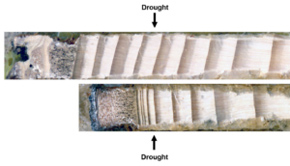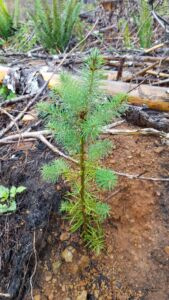SilviScan is a multifaceted technology comprised of an advanced suite of software and instruments including a cell scanner, x-ray densitometer, and x-ray diffractometer, which are used together to measure wood structure and quality that are most relevant to industry.
 (1) Photo credit: Natural Resources CanadaThis technology can measure the tiniest fibre dimensions within a tree and the data may then be used to map the forests of an entire region. Recent work is also demonstrating its utility in providing accurate and reliable estimates of carbon dioxide consumption in forests to support climate-change research.
(1) Photo credit: Natural Resources CanadaThis technology can measure the tiniest fibre dimensions within a tree and the data may then be used to map the forests of an entire region. Recent work is also demonstrating its utility in providing accurate and reliable estimates of carbon dioxide consumption in forests to support climate-change research.
The integrated set of instruments is designed to evaluate samples taken non-destructively from standing trees. A cylindrical sample taken from the bark through to the tree’s center (pith) weighs just a few grams and is enough to detect the wood and fibre properties of a tree. FPInnovations is one of only three organizations in the world that owns one. The technology has recently been used by a group of Canadian researchers to quantify impact of weather conditions on Douglas fir.
Addressing real-world challenges*
 (2) Photo credit: Natural Resources CanadaClimatic extremes, like the drought and heat event that is currently being experienced in British Columbia, are a major cause of concern in forestry. In this province alone, between 250 and 300 million seedlings are planted annually, costing about $1 per tree. Historically, temperate or cooler climates are no exception, with drought-induced dieback and mortality of western redcedar and Douglas-fir in BC’s coastal rainforest ecosystems repeatedly making headlines. These trees are ecologically, culturally, and socially significant and are also two of Canada’s most valuable timber species.
(2) Photo credit: Natural Resources CanadaClimatic extremes, like the drought and heat event that is currently being experienced in British Columbia, are a major cause of concern in forestry. In this province alone, between 250 and 300 million seedlings are planted annually, costing about $1 per tree. Historically, temperate or cooler climates are no exception, with drought-induced dieback and mortality of western redcedar and Douglas-fir in BC’s coastal rainforest ecosystems repeatedly making headlines. These trees are ecologically, culturally, and socially significant and are also two of Canada’s most valuable timber species.
Even if trees survive, timber value can also be substantially affected by climatic extremes. Damage can cause cellular deformities in the wood; this creates zones of weakness in the tree that can severely impact wood quality and value of timber. As droughts, heatwaves, and spring frosts are expected to become more frequent and severe, there is an urgent need to find solutions to adapt forests to such extreme variability.
Using SilviScan to support reforestation
 (3) Photo credit: Natural Resources CanadaAnnual reforestation efforts provide an opportunity to carefully select climate-resilient trees for planting. Searching for the most resilient trees is now a top priority for a joint team with the Canadian Wood Fibre Centre and the BC Ministry of Forests, Lands, Natural Resource Operations and Rural Development – and this work is made possible thanks to unique tools offered by FPInnovations.
(3) Photo credit: Natural Resources CanadaAnnual reforestation efforts provide an opportunity to carefully select climate-resilient trees for planting. Searching for the most resilient trees is now a top priority for a joint team with the Canadian Wood Fibre Centre and the BC Ministry of Forests, Lands, Natural Resource Operations and Rural Development – and this work is made possible thanks to unique tools offered by FPInnovations.
The team has found that growth response to drought is a heritable and variable trait in both coastal Douglas-fir and western redcedar. This is great news for tree breeders who can screen tree populations for drought resilience. However, scientists also need to understand the underlying mechanisms behind drought responses to better predict forest productivity and mortality under future extreme events. This is made possible by SilviScan, which enables quantification of wood properties at the cellular level. Using x-ray densitometry, x-ray diffractometry, and image acquisition, tree increment cores are scanned at exceptionally high resolution, which generates information on key cellular traits or wood properties within or across tree rings as well as to assess how climate variability is linked to variations in the wood, and to understand how different trees cope with drought.
Helping in the decision making
The ability to rapidly respond to changing environmental conditions varies with each individual tree and such wood quality traits are often under genetic control. Therefore, the kind of information provided by SilviScan can help select individual trees for further use in tree improvement programs, specifically selecting trees that can cope best with climatic extremes while maintaining high wood quality.
This helps ensure that the millions of trees planted annually will grow into forests that are resilient under severe climate events and maintain high value, showing how information from tiny cells using SilviScan can have significant impact on the landscape and the communities relying on healthy, productive forests.
For additional information on Silviscan, please contact
* Written in collaboration with Miriam Isaac-Renton, Research scientist at the Canadian Wood Fibre Centre
(1) Forest genetics field experiments are the basis of tree improvement programs. They involve testing the performance of trees in highly-replicated designs under real-world conditions. In the past, these experimental trials were used to make selections for tree improvement programs using commercially-important traits like growth performance. As these valuable experiments grow older, like the one shown above for coastal Douglas fir, growth of mature trees to drought and other climatic extremes can be analyzed retrospectively using tree rings.
(2) Tree increment cores from non-destructively sampling trees show annual growth increments, which serve as archives of past responses to climatic extremes. When tree ring analyses are performed in mature forest field experiments, several key factors are accounted for. For example, the two increment cores shown in the image above show growth trends from two trees that were planted at the same time and grown at the same location – but represent different families in a tree breeding population. The tree in the upper part of the figure showed consistent growth responses under drought. The tree in the lower part of the image showed low drought resilience, defined here as the ability to regain pre-drought growth levels. The literature indicates that such low resilience can often precede tree death. Analyses from thousands of trees from these highly-replicated experimental sites indicate that the growth response of coastal Douglas-fir to drought is a highly variable and heritable trait – and therefore under the control of tree breeders. This is fortunate, because tree breeders can use this type of knowledge to screen out the trees expected to perform worst under climate change from reforestation programs.
(3) Since about 15 million coastal Douglas-fir trees are planted in British Columbia every year, and practically all of those seedlings are from class A seedlings derived from tree breeding programs, incorporating new traits into the tree breeding program can lead to major benefits over time.
Source: FPInnovations
